The multidisciplinary exhibition COLOUR: Art, Science & Power showcased diverse and exceptional objects from across the University of Cambridge Museums.
Colour is all around us. It reflects and influences our understanding of the world, our emotions, creativity and relations with others. The interdisciplinary exhibition COLOUR: Art, Science & Power at the Museum of Archaeology & Anthropology (26 July 2022 – 23 April 2023) aimed to engage diverse audiences and encourage visitors to explore the ways that colours are created, perceived, given meaning and experienced. Read on for an overview of the process of creating the exhibition plus visitors’ responses.
COLOUR drew on the outstanding and diverse collections from across the University of Cambridge Museums, plus its colleges and libraries. It included paintings, scientific instruments, Greek and Egyptian antiquities, medieval manuscripts, African carvings, Amazonian feather headdresses, Hawaiian cloaks, minerals, zoological specimens and much more. As Lead Curator working closely with Research Assistant Tom Crowley, we were privileged to access such rich material and benefit from the expertise of colleagues and the insights of Indigenous and local community members.
A link to Tom Crowley’s blog is available here: https://www.museums.cam.ac.uk/blog/2023/12/22/colour-art-science-and-power/
The exhibition began with Kaleidoscope (see header image), an explosion of colour captured in crochet, specially made for the exhibition by a local grassroots arts group the Cambridge Yarn Collective – Hillary Butler, Clare Collier, Sophie Neville and Dorothy Singer (MAA 2023.8) I was struck by the public response to their installation of crocheted ‘suns’ along the tennis court railings in Jesus Green, which appeared at winter solstice during COVID and brought colour and brightness to viewers at the darkest time of the year. In addition to developing links with community well-being, the design of Kaleidoscope was inspired by our discussions about how humans perceive colour. Ideas were drawn from scientific and artistic debates around which colours should be included in the colour wheel, and Seurat’s notion that colours are mixed by the eye when placed next to each other.
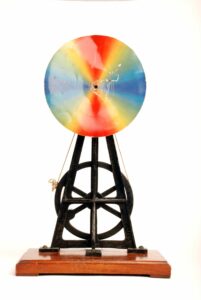
The exploration of colour was developed and presented as a series of over-lapping ‘clusters’ of ideas and objects linked to particular themes – experience, perception, measurement, desire, power, identity and global marketing. Adopting an exploratory approach, and utilizing curatorial techniques of juxtaposition and assembly, the exhibition raised questions and encouraged visitors to reflect on their personal experiences of colour and make their own links between the themes and the objects on display.
What is colour?
The perception of colour is scientifically understood as the result of the brain’s interpretation of different light waves. Visitors enthusiastically interacted with the perception quizzes within the gallery, which revealed the extent to which colour is ‘in the mind’. Yet as demonstrated by artists’ materials from the Hamilton Kerr Institute and an Australian Aboriginal ochre bark painting, colours are also material substances that we experience and interact with in our daily lives.
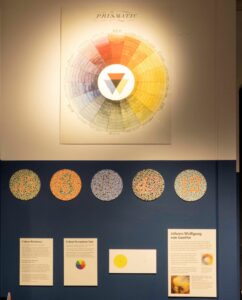
Gallery view: The section on Colour Perception included interactive perception tests which revealed the extent to which colour is in the mind. Visitors were encouraged to stare at a black dot at the centre of a yellow circle and then look at a dot on a white background. For many people this produced a bluish purple after-effect. A row of circles with numbers composed of different coloured dots are used to test for colour blindness.
Colour & Desire
During research for the exhibition I was amazed by the enormous efforts that have gone into producing particular colours. Over millennia colour has been laboriously extracted from the earth, plants and animals, squeezed from the glands of molluscs and, from the 1950’s onwards, extracted from coal tar. The processes involved are often highly skilled, smelly and sometimes dangerous. Every colour has its own history. Specific colours travelled great distances along the trade routes of empire and commerce. The section on desire focused on two particularly potent examples – the rich ultramarine blue extracted from lapis lazuli and the brilliant red cochineal derived from the bodies of scale insects. With the assistance of research scientists at the Fitzwilliam Museum and HKI, various techniques including Fibre Optic Reflectance Spectroscopy (FORS) and Visual Induced Luminescence (VIL) were used to identify ultramarine, Egyptian blue and insect red.
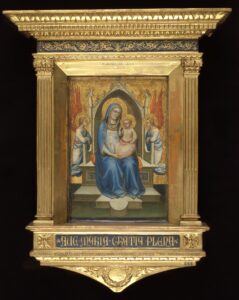
Virgin and Child Enthroned with Two Attendants, 1400 – 1403 Lorenzo Monaco (1370 – 1425) Italy. This sumptuous painting combines the two most valuable substances – ultramarine for the Virgin’s robes and the gold used for the halos, background and frame. Fitzwilliam Museum 555.
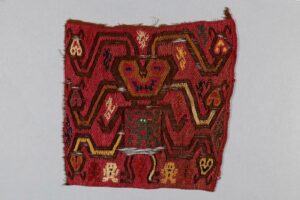
Embroidered woolen textile fragment with a human-like figure with six radiating serpents. The rich red woollen background is from an insect-based dye known as cochineal. Peru, Wari people, c. 600-1000 CE. MAA 1935.326
Black & White
Colour has profound and far-reaching political implications. It is restricted to elites, deployed as a means of empowerment and used to categorise and discriminate against particular groups of people. A cluster towards the end of the exhibition drew on classical Greek imagery, contemporary artworks and the poem White Comedy by Benjamin Zephaniah to raise questions and challenge the artificial category of ‘race’. The ambiguity of a Janus-faced Athenian Kantharos cup, which juxtaposed dark and light-coloured female heads, became a productive springboard for discussion. Consultation with local community groups, including the UCM Cambridge Community Forum, the Cambridge students’ African & Caribbean Society and QTI (Queer, Trans and Intersex) Coalition of Colour, was crucial to the development of the interpretation. Through discussions on-line and (most productively) in the gallery with images of possible objects for inclusion we developed an open-ended approach to the display, which aimed to raise questions and encourage reflection. The question ‘What do you see?’ on the label was followed by ‘We don’t know how the ancient Greeks would have understood this cup, but we do know that they didn’t use ‘black’ or ‘white’ to describe people in the way that the terms are often used today’. The idea that people can be classified by the oppositional colours of black and white emerged in Europe and America over the past four centuries. It developed in tandem with the artificial category of race.
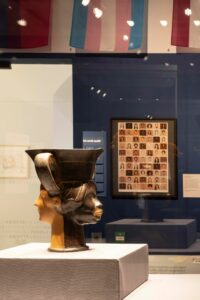
Immediately opposite the Kantharos was Angélica Dass’s artwork Humanae which highlighted the colours we share by juxtaposing dozens of portraits of people from a variety of ancestral backgrounds. Rainbow Pride flags hung from the ceiling above, selected by Cambridge-based Queer People of Colour. Evaluation and informal Interviews with visitors to the exhibition indicated that some people deeply engaged with the open and questioning curatorial approach (cross reference to blog by Tom Crowley).
The COLOUR exhibition attracted nearly 70,000 visitors over nine months. Although the exhibition was dense, it was extremely popular, with front of house and gallery staff commenting that it ‘had something for everyone’. Overall, we had an overwhelming response to the question ‘What does colour mean to you?’ posed towards the end of the exhibition. Thousands of people posted hundreds of comments and drawings on to the feedback wall in the form of a human face. Their unique responses referred to a range of themes present in the exhibition – the electromagnetic spectrum, feelings, symbolism, nationalism, gender, medical conditions and changes in nature – but the overwhelming focus was experience. As highlighted by one respondent, ‘Colour is a feeling’.
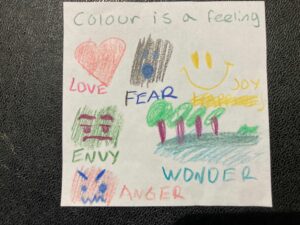
COLOUR: Art, Science and Power was an ambitious exhibition made possible by the insights and collective work of dozens of people across the University of Cambridge Museums and beyond. The integration of multiple viewpoints – including those put forward by members of Indigenous and local communities – enabled us to engage with diverse, complex and culturally sensitive issues. In addition to the usual MAA limitations of space and resources, the main challenge was restricted access to collections and ongoing staff illness resulting from COVID. Plans for an extensive multi-authored catalogue were not realised and the overall process would have benefited from a longer period of consultation and collaboration.
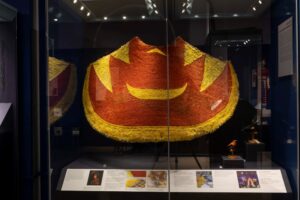
Numerous resources remain accessible on line at https://maa.cam.ac.uk/colour-art-science-and-power including virtual tour, a downloadable pdf of the small catalogue and a short film ‘Making Kaleidoscope’ with the Cambridge Yarn Collective.







